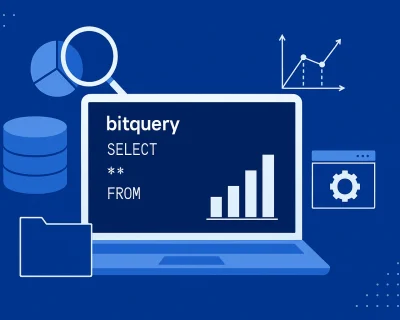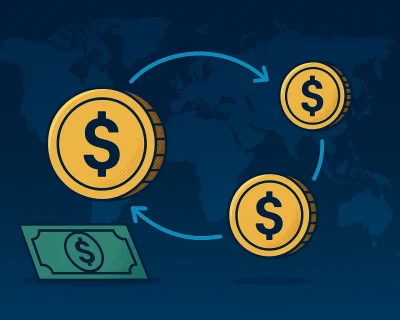XLM vs. XRP: Which One is the Better Choice in 2025?

Have you ever wished sending money overseas was as easy as pinging your mate on your phone? That's the goal of cryptocurrencies like XLM (Stellar Lumens) and XRP (Ripple).
Both are shaking things up in the world of finance, promising to blast through those slow and pricey international transfer fees. But with all the crypto talk and crazy names, figuring out which one to use can feel like trying to crack a code.
No worries, though! This guide will ditch the confusing jargon and break down the key differences between XLM and XRP in a crystal clear way. We’ll talk about who they’re trying to help, how many coins are actually out there (their maximum supply), and that super-fast transaction speed they brag about.
By the end of this, you’ll be a pro at choosing your new best friend for sending money around the globe. So, ditch the FOMO and get ready to unlock a future where sending money overseas is as smooth as, well, sending a text!
What is Stellar (XLM)?

Stellar is a decentralized blockchain platform developed by the Stellar Development Foundation (SDF). Its primary cryptocurrency trades under the symbol XLM on various exchanges, and is integral to the Stellar decentralized network, facilitating transaction fees and account initialization.
Stellar’s mission is to connect banks, payment systems, and individuals to enable low-cost, cross-border, and cross-asset financial transactions. This decentralized protocol operates on open-source code, making it accessible and transparent for users worldwide.
Stellar’s network is designed for efficiency and speed, with transactions typically being confirmed within 3-5 seconds.
Stellar operates on the Stellar Consensus Protocol (SCP), a unique protocol that uses a federated Byzantine agreement (FBA) model, where trust is established through a network of mutually trusted nodes.
This approach ensures fast and secure consensus without the high energy consumption associated with PoW systems. The SCP allows the network to remain decentralized while maintaining high throughput and resilience against attacks.
The Stellar Development Foundation, a nonprofit organization founded by Jed McCaleb, oversees the network. The project initially received funding from the payments startup Stripe and various other donations, including tax-deductible public contributions.
In 2018, Stellar expanded its reach by signing an agreement with TransferTo for cross-border payments across more than 70 countries. It also became the first distributed ledger technology to receive Shariah compliance certification for payments and asset tokenization.
Additionally, Stellar partnered with IBM on a double-pegged stablecoin project, enhancing its credibility and adoption in the financial sector.
Stellar created 100 billion XLM at its launch. In 2019, the Stellar Development Foundation implemented a significant change by burning 55 billion XLM, reducing the total supply to 50 billion. Of these 50 billion XLM, around 29 billion are in circulation, with the rest held by the SDF for development and promotional purposes.
Stellar has established itself as one of the leading altcoins, boasting a significant market capitalization. Its unique features and strategic partnerships position it as a pivotal player in the blockchain technology and cryptocurrency landscape.
What is XRP?

Ripple, often confused with its native digital currency, XRP, represents a pioneering approach to digital payments and financial settlements.
Founded by Jed McCaleb in 2012, Ripple Labs embarked on a mission distinct from traditional blockchain technologies like Bitcoin and Ethereum. Unlike these platforms, Ripple operates on the Ripple Protocol Consensus Algorithm, which forgoes the energy-intensive mining and validation mechanisms in favor of transaction facilitation through consensus among network participants.
This unique approach not only enhances transaction speeds but also minimizes energy consumption to near-negligible levels, a stark departure from Bitcoin’s energy-intensive operations.
XRP, the digital currency associated with Ripple, operates within RippleNet, a digital payment platform designed for rapid financial transactions across borders. While Ripple Inc. oversees RippleNet (Ripple Network), the XRP Ledger—a pivotal ecosystem component—operates as an open-source protocol, not strictly based on blockchain but utilizing Distributed Ledger Technology.
The XRP Ledger employs a Federated Byzantine Consensus model, wherein nodes collaborate to validate transactions swiftly and efficiently, achieving consensus within 3-5 seconds of a transaction’s initiation.
Companies accessing RippleNet do so via gateways, which serve as entry points for entities outside the network. As a for-profit entity, Ripple targets financial institutions and corporations seeking alternatives to conventional banking systems.
Central to Ripple’s architecture is XRP, which was initially issued in 2012 to facilitate seamless payment transfers within RippleNet. XRP was pre-issued with a fixed supply of 100 billion units. It enables quick and efficient transaction settlement at a rate of 1,500 transactions per second, making it a robust tool for financial institutions aiming to facilitate cross-border transactions.
XLM vs. XRP: Key Similarities
As you can see in the descriptions of each project provided above, XLM and XRP share several similarities that position them as key players in international money transfers.
The Founder
And let’s start with the most obvious one: these projects’ founders. Or, better said, the founder. A notable connection between these two platforms is Jed McCaleb, a major figure in the crypto industry, who played a key role in developing both Ripple and Stellar.
Efficiency in Transactions
Moreover, both Stellar and Ripple are designed to make sending money across borders as simple and cost-effective as sending an email. They excel in efficiency, with transaction speeds that process transfers in 3-5 seconds, a significant improvement over the often lengthy delays of traditional bank transfers.
Affordability
Affordability is another cornerstone of both platforms. While traditional banking systems can incur high fees for international transfers, XLM and XRP focus on minimal costs, making international payments more accessible and economical.
Strategic Partnerships
Furthermore, XLM and XRP are actively forming strategic partnerships with established financial institutions. Collaborations with banks and technology firms are helping to drive the mainstream adoption of these cryptocurrencies.
XLM vs. XRP: Key Differences
Despite sharing common goals, XLM (Stellar Lumens) and XRP (Ripple) exhibit key differences in their design, distribution, target audience, and consensus mechanisms.
Design and Target Audience
XRP is developed and maintained by Ripple, a private company. Ripple’s network is primarily intended for banks and financial institutions, providing them with a streamlined way to handle international transfers without relying on the traditional SWIFT system. The permissioned nature of Ripple’s network means that its primary users are large financial entities seeking efficiency and reduced costs in cross-border transactions.
Conversely, XLM is fully decentralized and designed to serve individuals and small businesses, particularly in developing countries. The Stellar Development Foundation (SDF), which oversees Stellar, positions the platform as a not-for-profit entity. Its mission is to provide financial services to the unbanked and underbanked populations, enabling them to engage with the global financial system. This approach reflects Stellar’s focus on accessibility and social impact rather than profit maximization.
Market Capitalization
Historically, XRP has often been ranked within the top 10 cryptocurrencies by market capitalization. More precisely, at the time of writing, XRP is ranked on the 4# place, with a market cap of almost $124 billion. It has largely maintained a higher market cap than XLM, signifying a larger market share.
XLM has a smaller market capitalization relative to XRP, at only $8.3 billion at the time of writing. XLM is currently ranked at 35th place by market cap.
Token Distribution
XRP and XLM differ notably in their token distribution models. When Ripple launched, it created a fixed supply of 100 billion XRP tokens, all minted at the outset. This fixed supply cannot be altered, making XRP a deflationary asset as tokens are gradually used up or lost.
In contrast, Stellar initially created 100 billion XLM tokens, with an annual increase of up to 1% permitted. However, following community votes, the number of tokens was reduced to 50 billion to better manage inflation and value. This gradual and community-influenced distribution method contrasts with Ripple’s fixed supply approach.
Inflation and Deflation
XRP is a deflationary currency, meaning its purchasing power is likely to increase over time due to its growing scarcity. This is because XRP’s transaction fees are burned, permanently removing them from circulation.
In contrast, Stellar has a fixed annual inflation rate of 1 percent. This inflation rate helps ensure that people who have access to XLM can continue to receive a stable value for the currency as global inflation progresses.

Consensus Mechanism
XRP and XLM use different consensus mechanisms to validate transactions on their networks.
XRP employs the Ripple Protocol Consensus Algorithm (RPCA). This protocol relies on a Unique Node List (UNL), where selected nodes validate transactions through multiple rounds of voting. RPCA is efficient and less energy-intensive as it does not depend on mining or staking, ensuring quick and secure transaction processing.
On the other hand, XLM uses the Stellar Consensus Protocol (SCP), which operates through a federated voting process. Nodes in the Stellar network are grouped into smaller federations, each with its list of trusted nodes.
Transactions are broadcast to all federations, and validation occurs through independent voting within these groups. A transaction is validated once it receives a sufficient number of votes from multiple federations, emphasizing decentralization and security.
XRP and XLM: Side-by-Side Comparision
| Feature | XLM (Stellar Lumens) | XRP (Ripple) |
| Similarities | ||
| Founder | Jed McCaleb | Jed McCaleb |
| Transaction Speed | 3-5 seconds | 3-5 seconds |
| Transaction Fees | Low | Low |
| Goal | Designed for international payments | Designed for international payments |
| Strategic Partnerships | Actively forming partnerships | Actively forming partnerships |
| Differences | ||
| Target Audience | Individuals, small businesses | Banks, financial institutions |
| Network Type | Decentralized (Open Source) | Permissioned (Private company) |
| Market Cap (as of writing) | $8.3 billion | $124 billion (higher) |
| Token Distribution | Initially 100 billion, reduced to 50 billion | Fixed supply of 100 billion |
| Inflation/Deflation | 1% annual inflation | Deflationary (tokens burned) |
| Consensus Mechanism | Stellar Consensus Protocol (SCP) | Ripple Protocol Consensus Algorithm (RPCA) |
FAQs
Is XRP or XLM Better?
There is no definitive answer to whether XRP or XLM is better, as both have unique strengths and weaknesses. They share similarities, such as enabling near-instant and low-cost transactions, but each serves different purposes and target audiences.
Is XLM the Same as XRP?
No, XLM and XRP are different. XLM is the native token of the Stellar network, designed to facilitate trades for unbanked individuals.
In contrast, XRP is a cryptocurrency created by Ripple Labs Inc., intended for use by banks and financial institutions as a store of value and for facilitating cross-border transactions.
Which Is Considered a Better Investment, XLM or XRP?
The better investment between XLM and XRP depends on individual risk tolerance, market analysis, and personal investment goals. XLM focuses on creating a decentralized financial system for the unbanked, while XRP targets institutional payment systems. Each has its own value proposition and associated risks.
Is There an Existing Partnership Between XRP and XLM?
There is no formal partnership between XRP and XLM. They operate on separate platforms—Ripple for XRP and Stellar for XLM—each created with different visions and goals for their respective cryptocurrencies.
What Are the Discussions on Reddit Indicating about Investor Preference Between XLM and XRP?
Reddit discussions reveal diverse opinions, with some users favoring XLM for its focus on serving unbanked populations and others preferring XRP due to its strong partnerships with financial institutions. Investor preference often hinges on personal investment philosophy and trust in each project’s vision and execution.
Conclusion XRP and XLM: Which One is a Better Investment?
Both XRP and XLM offer unique benefits and cater to different audiences. Ripple is tailored for banks and financial institutions, providing efficient cross-border payments, while Stellar aims to provide financial services to individuals and small businesses, particularly in underserved regions.
Your choice between them (and any digital assets) should align with your risk tolerance, investment goals, and the specific benefits you seek. Conduct thorough research to make an informed decision that fits your financial strategy.













